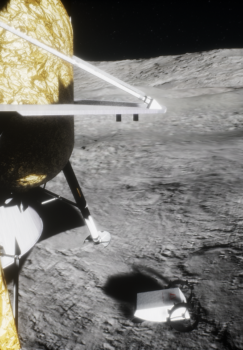It’s called CubeRover – a novel and new small rover platform for the Moon.
Astrobotic, in partnership with Carnegie Mellon University, has been selected by NASA for a Phase II Small Business Innovation Research (or SBIR) Award to develop this 4.4 pound (2-kilogram) rover platform capable of small-scale science and exploration on the Moon and other planetary surfaces.
“CubeRover stands to give more people access to the Moon than ever before,” said Andrew Horchler, principal investigator of the program at Astrobotic. “Countries and organizations without multi-billion-dollar budgets now have a means of exploring other worlds for the first time,” he said in an Astrobotic press statement.
Rapid development
In Phase II the team presses forward with a rapid, two-year development to deliver a flight-ready rover to NASA. The team intends to fly the first CubeRover on Astrobotic’s Peregrine lunar lander to the Moon in 2020.
Headquartered in Pittsburgh, Pennsylvania, Astrobotic Technology, Inc. is a lunar logistics company established to deliver payloads to the Moon for companies, governments, universities, non-profits, and individuals.
NASA catalyst
The company is an official partner with NASA through the Lunar CATALYST program, has 24 prior and ongoing NASA contracts, a commercial partnership with Airbus DS, a corporate sponsorship with DHL, 11 deals for its first mission to the Moon, and 130 customer payloads in the pipeline for upcoming missions, according to the group.





Hello Leonard,
Mu question – Is this “Cuberover” doomed to die during the long
and very cold lunar night (almost 15 Earth days)?
Ron
Response from Astrobotic:
The lunar night is indeed very cold – surface temperatures drop to liquid nitrogen levels. This is particularly harsh on sensitive electronics and batteries and especially challenging for a small and inexpensive rover.
Like NASA lunar missions (e.g., Resource Prospector) and Astrobotic’s own Peregrine Lander, we do not anticipate surviving the night. The rover will go into hibernation mode when power levels and temperatures drop below a threshold. We will attempt to re-acquire contact on the following lunar day, but there is no guarantee for long-term survivability.
CubeRover’s low cost is an advantage relative to larger systems that cost $100M+ and still cannot guarantee surviving lunar night. In future missions, CubeRovers will be be designed to take advantage of lander-based systems to shelter for the night. In addition, larger CubeRovers will allow for more thermal insulation and be able to carry heavier electronics and batteries custom-designed and qualified for ultra-low temperatures. Astrobotic has previously done research in this area.
Could the mini rover be made to dig under the lunar dust to shield it from lunar night temperature extremes ?
Maybe a plow on the rear that wood dig into the dust only when it backs straight backwards …?
What do eye know …was even a real good locomotive electrician.
Leave the moon alone please.